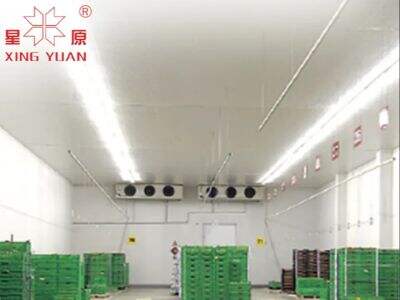Хладњаче су кључне за одржавање свежине производа од производње све до тренутка продаје. Ове просторије намерно се држе хладним да би се осигурала свежина скоропротрачних производа као што су воће, поврће, месо, млечни производи итд. Ови производи би се покварили и били небезбедни за људску исхрану без тога hladna soba .
Значај хладњача у одржавању свежине производа.
Хладњаче су у основи велике верзије фрижидера, које користе супермаркети и ресторани да би зачували скоропротрачне производе од кварења. Производи који су хлађени у hladne sobe могу да се одрже свежи дуже време и могу се транспортовати на удаљена места без да се покваре. То је важно јер значи да људи могу ужинати у широк асортиман свеже хране током целе године, без обзира на то где живе.
Напредне технологије које чувају ланац хлађења током транспорта.
Нови Стар је био на челу у развоју нових технологија које помажу у одржавању интегритета ланца хладњача унутар оптовртне снабдевачке мреже. Једна од тих иновација су возила за хладни ланац са посебним сензорима који су дизајнирани да прате и контролишу температуру приликом транспорта производа. Ови сензори у реалном времену шаљу информације централном систему за надзор, тако да можемо да пратимо температуру наших производа кроз сваку фазу процеса.
Најбољи методи за осигуравање контроле температуре и минимизирање квара производа.
А како би се максимално побољшала контрола температуре и смањила штета, важно је пратити најбоље праксе, као што су начини паковања, утовара и истовара кутија. Ради очувања свежине, производи се морају враћати у изолованим материјалима за испоруку. Поред тога, утовар и истовар морају се ефикасно обавити, тако да производи не остану ван hladna soba i soba za zamerzavanje дуже време. На тај начин, роба се одржава на правoj температури током читавог снабдевачког ланца.
Зашто су хладне просторије важне за одржавање безбедности хране.
Питање је у томе да су хладне просторије важан део заштите хране од штетних бактерија које могу изазвати озбиљна болења стомака. Продукти се чувају на ниским температурама како би се спречио раст бактерија и како би производи били безбедни за употребу. Ова чињеница је посебно важна у случају скоропротрајних производа као што су месо и млечни производи, јер небезбедни услови складиштења могу довести до бактериолошког загађења.
Како праћење температуре у реалном времену доноси прозрачност и ефикасност у ланцу снабдевања?
Даљинско праћење температуре је један од највећих променилаца у логистици и оптицају снабдевања, као и у прозрачности, поред ефикасности. Уместо тога, можемо у реалном времену уочити било какве проблеме са температуром пратећи температуру производа и предузети неопходне мере. Захваљујући нивоу детаља у овим системима, производи могу достићи потрошаче у највишем квалитету, ограничавајући кварење и повећавајући поверење у квалитет производа. Додатна предност је да дневници праћења и трагања температуре помажу у поједностављивању процеса у ланцу снабдевања, истовремено штедећи време и новац на управљању проблемима температуре у лету.
Table of Contents
- Значај хладњача у одржавању свежине производа.
- Напредне технологије које чувају ланац хлађења током транспорта.
- Најбољи методи за осигуравање контроле температуре и минимизирање квара производа.
- Зашто су хладне просторије важне за одржавање безбедности хране.
- Како праћење температуре у реалном времену доноси прозрачност и ефикасност у ланцу снабдевања?
 EN
EN AR
AR BG
BG HR
HR CS
CS DA
DA NL
NL FR
FR DE
DE FI
FI EL
EL HI
HI IT
IT JA
JA KO
KO NO
NO PL
PL PT
PT RO
RO RU
RU ES
ES IW
IW ID
ID LT
LT SR
SR SK
SK LV
LV SL
SL ET
ET IS
IS LA
LA SV
SV UK
UK SQ
SQ GL
GL HU
HU TH
TH AF
AF CY
CY FA
FA
